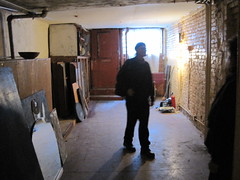A storefront space on First Street is empty but for a stylized mirror in the shape of Babe Ruth – one of the few odds and ends left over from the previous tenant, a mirror and glass designer. The owners of the former studio are looking for a new tenant – and not a bar. But the space has a boozy past: it once held a tavern that Emma Goldman, the influential anarchist who counted herself a regular, called “the most famous radical center in New York.”
During the turn of the 20th century, 50 East First Street was the home of Justus Schwab’s saloon. Just 8-foot wide by 30-foot deep, it was described as a “bier-höhle” (or “beer-cave”), a pun on “bierhalle.” Though small in size, the tavern was a “mecca for French Communards, Spanish and Italian refugees, Russian politicals, and German socialists and anarchists who had escaped the iron heel of Bismarck,” according to Goldman, who spent so much time there that she had her mail sent there.
Christin Couture and William Hosie, who are members of the board that owns the building, said that the space had been vacant for a year. (The asking rent is between $3,000 and $3,500 per month.) Mr. Hosie said they were “not about steep rent hikes” and suggested they might be looking for someone unable to afford the ever-rising rents elsewhere in the neighborhood.
“A few people are interested, all in the gallery, bookstore, design workshop area,” said Ms. Couture. “The coop knew it didn’t want a restaurant or another bar. They wanted something dry and relatively quiet.”
The address wasn’t so quiet when it was home to Justus Schwab’s tavern. In 1874, its proprietor – a broad-shouldered, red-haired German-born anarchist whose friends called him “an imposing man” and “a Viking” – was famously arrested during the Tompkins Square Riot for charging the square carrying a red banner and chanting the “Marseillaise.” As described in “Beer and Revolution” by Tom Goyens, Schwab was what the Marxist intellectual Daniel De Leon once called a “lager-beer anarchist,” and also the leader of a German anarchist singing group: his song-leading and occasional “comedic acts” were said to enliven his pub.
The music critic James Gibbons Huneker remembered that, upon request, Schwab “played the ‘Marseillaise’ and the ‘International Hymn’ on an old piano – smoke-stained, with ratting keys and a cracked tone – which stood at the rear [of the tavern] upon a platform.”
Goldman, in her memoir, said she came to the tavern “to listen to Justus’s golden voice, drink his delicious beer and wine, and argue world problems far into the night.” She also did work there (the pub had its own library of more than 600 volumes, from which she frequently borrowed) and hear political lectures in the back room, where, over a glass of Rhine wine and seltzer, she once told a New York Sun reporter, “I was born a revolutionist.”
Many writers were also regulars, including the editorialists John Swinton and Ambrose Bierce, and Sadakichi Hartmann, the poet and critic. The bar was decorated with a bust of Shakespeare and several frames depicting the French Revolution.
Starting in 1880 the back room was also the meeting place for the Social Revolutionaries Club, a group of left-wing socialists and anarchists, of which Goldman was a member.
Not surprisingly, Schwab’s tavern was targeted by the temperance movement, and was raided several times by police. Schwab himself was once arrested for selling beer on a Sunday. Mr. Huneker recalled police suddenly raiding the pub in the middle of Schwab singing the “Marseillaise,” and the music critic was himself hauled off to the police station with the other patrons.
Schwab died in 1900 after contracting tuberculosis five years earlier. Although his son, Justus Jr., took over the pub, Goldman remembered the tavern keeper’s death as a personal loss and also a turning point for the immigrant anarchist scene. “The loss of Justus increased the dullness of my life,” she wrote. “The small circle of friends who used to meet at his place was now scattered; more and more I withdrew into my own four walls.”
Schwab’s funeral was nevertheless attended by some 2,000 people, in what The Times reported was a unique show of unity among conflicting factions within the anarchist movement.
The former site of the saloon was later used in the early 20th century as a grocery and meat market.
Asked if the coop hoped to find a tenant who shares the spirit of Goldman’s time, Ms. Couture said, “That would be almost like a miracle. That would be too good to be true.”
Still, she added, “We like strong characters that create an atmosphere.” Just don’t plan on pouring beer on Sundays.






